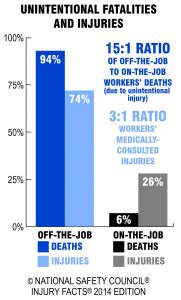Imagine you’re a line worker at a busy automotive plant. Or you work on power lines where you have to contend with thousands of volts of electricity, or on an oil rig with immense pressure running through pipes.
These are dangerous jobs with a great deal of hazardous energy, and it wouldn’t be hard to get seriously injured or killed working at jobs like these. That’s why most companies have a rigorous safety program in place, health and safety managers, and strict rules and procedures—all to keep employees safe at work.
But there is something missing from all these safety programs—they only focus on the workplace.
When workers get in their cars to drive home, the rules, safety programs and H&S supervisors disappear.
That’s why three times more injuries and 15 times more deaths occur off-the-job than on-the-job due to unintentional incidents.
And when injuries happen when workers are off the clock, there is a sizeable cost to employers:
- If an employee can no longer work due to injury the average cost of replacement is 20% of the employee’s annual salary.
- When employees miss time at work, on average there is a 19% increase in delays, postponements and missed work.
- The total cost of lost productivity due to health-related absenteeism is $84 billion per year.
The moral is that unintentional injuries to workers cost their employers big money—and it doesn’t matter whether the worker was injured on or off the job.
Do your safety efforts reduce off-the-job injuries? If it doesn’t then there’s a huge blind spot in your safety program.
SafeStart offers 24/7 safety skills to keep workers safe whether they’re at work, at home or on the road—and that can save your company tons of money each year. Even small companies have proven they can save big.
And on top of the financial savings, you’ll also be giving your employees essential safety skills that will help them avoid injury at work, at home and on the road.


